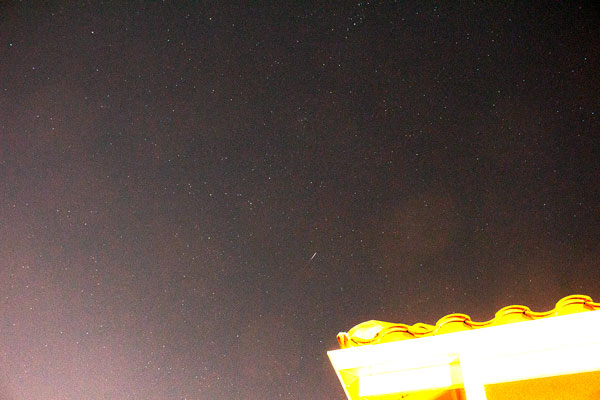Well, SpaceX launched another constellation of Starlink satellites early Wednesday morning, so let's go out on this Saturday evening and see if we can spot any on their predicted pass over Orange County.
So, the launch was on Wednesday and when I checked for visual passes over Orange County on Friday, the next pass would be Saturday night. Check out a typical sky chart for one of the satellites below. This star chart and other observing details was provided by Heavens-Above. This set of passes are apparently not going to be very visible because they seem to come up over the horizon at about 10 degrees elevation and magnitude 6.0. This is not going to be visible for me here in city lights polluted viewings. Even as the satellite gets higher in the sky, the visual magnitude barely reaches a predicted 2.6. Hmm, this does not seem like a good viewing opportunity for the beautiful "string of pearls" that we have seen in previous launches.
 |
| Sky Chart for one of the Starlink satellites for Saturday, Feb 1, in Orange County (Source: www.heavens-above.com) |
The predicted times for viewing in Orange County was from 6:36 pm to 6:48 pm. Since the predicted visual magnitude was only 2.6, it seemed that I was just going to have to point the camera in the general direction of the constellation Auriga, which is the location where the satellites were predicted to go behind the Earth's shadow.
So, I am out at 6:30 pm, with my lightweight tripod and Canon with 18-55 mm lens. I focus the camera on Venus, which was very bright in the night sky. I was worried that I might not be able to see any satellites if their maximum brightness was 2.6 because I can just barely make out Polaris at magnitude 2.0.
But, luckily, I could see some brief, occasional glimpses, maybe one or two seconds, of light in the general direction of where the Starlink satellites were supposed to be. I saw several instances of flashes of light and each flash was really a streak of light because the light was moving across the sky. So, with the camera pointing in that direction, I took several 8 second exposures.
Here is the first full frame image which actually shows a satellite. The camera is pointing up at elevation about 50 degrees and the left edge of the frame is to the northwest and off to right edge of the frame is north east.
 |
| Looking for Starlinks in IMG4357, 8 seconds, 18 mm DSLR (Source: Palmia Observatory) |
This image is just the cropped version of the previous image. The exposure time was 8 seconds but we can't be sure whether the streak was already visible before the camera exposure started or if the streak was still visible when the exposure stopped. However, this frame is certainly consistent with the prediction where the brightness of the satellite was thought to increase in brightness until it finally moved into the Earth's shadow.
 | |
|
The next successful frame was taken maybe 20 seconds after the previous frame. Again, you can see the streak of light in the same general orientation as the first image.
 |
| Looking for Starlinks in IMG4358, 8 seconds, 18 mm DSLR (Source: Palmia Observatory) |
This image is just the cropped version of the last image. This cropped image shows the streak of light in the same general orientation, but this time the streak appears to be brighter at the bottom end, unlike the previous image where it was brighter at the top end.
 | |
|
The last camera image that had any visible tracking or streaking is shown below. In this case there are two visible streaks of light, just above the edge of the roof.
 |
| Looking for Starlinks in IMG4359, 8 seconds, 18 mm DSLR (Source: Palmia Observatory) |
This cropped version of the previous image shows more clearly two parallel streaks of light.
 |
| Looking for Starlinks in cropped IMG4359, 8 seconds, 18 mm DSLR (Source: Palmia Observatory) |
Well after getting those two streaks of light, nothing else showed up. I could not see any other flashes of light. Hmm, I was at least glad to see something, but I was disappointed in not seeing the "string of pearls." I wonder why this constellation is not more easily visible? Previous viewings of of the string of pearls showed the satellites just moving 30-50 degrees across the sky. At least the clouds cooperated this time and we had a very clear sky! Anybody else out there see anything?
Until next time,
Resident Astronomer George
Be sure to check out over 300 other blog posts on similar topics
If you are interested in things astronomical or in astrophysics and cosmology
Check out this blog at www.palmiaobservatory.com

No comments:
Post a Comment